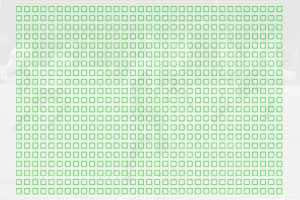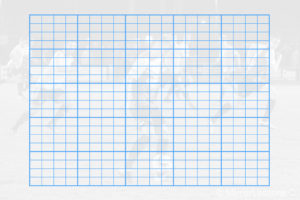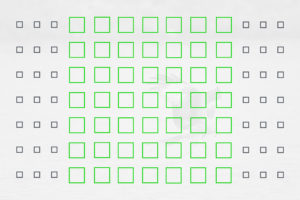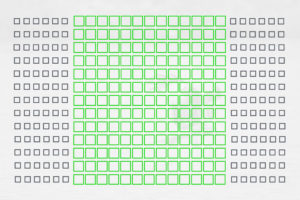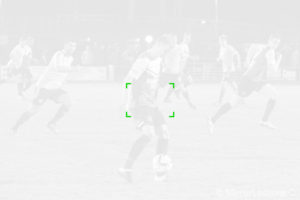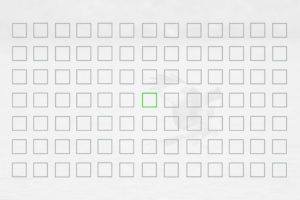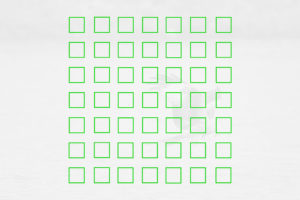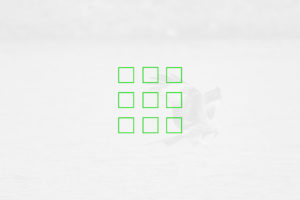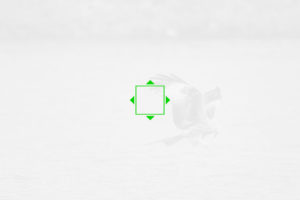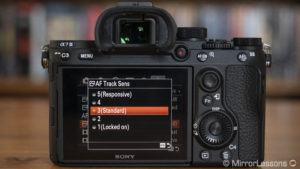You are now on page 3. Here you can read all our findings about the autofocus performance and continuous shooting speeds.
- Page 1: design and functionality
- Page 2: image quality
- You are on page 3: autofocus and speed
- Page 4: image stabilisation, video, other features and conclusion
[toc heading_levels=”2″ label=”Table of contents – Page 3″]
Autofocus system and general settings
The A7 mark III inherits the autofocus system of the A9. While the processing speed doesn’t match the capabilities of the flagship E-mount camera (where the AF is calculated up to 60 times per second), it retains the same number of phase detection points (693 that cover 93% of the sensor surface) and a minimum sensitivity of -3Ev. It also receives more contrast detection points with 425 areas.
The X-H1 inherits the same AF points seen on no fewer than five other Fuji cameras (X-T2, X-Pro2, X-E3, X-T20 and X100F). However the algorithm and the processing speed have been improved. You find 91 points that can be subdivided into 325 with certain settings. The central points are phase detection (49 or 169) whereas the areas on the left and right are contrast based only. The minimum sensitivity is -1Ev.
Because the phase detection points are organised across the entire sensor surface, the A7 III performs well even if the subject is on the far left or right side of the frame, whereas in the same case the X-H1 can slow down or be less precise because the phase detection points are confined to the centre.
The A7 has five different focus area modes:
- Wide uses all the points available on the frame
- Zone uses a group of 9 areas that you can move around the screen
- Centre as the name suggests, is a single area in the middle of the frame and can’t be moved
- Flexible Spot is a single area that comes with three sizes and can be moved
- Expand Flexible Spot uses a small point plus phase detection points around it if the single point is not enough to focus correctly. This has become my favourite Area mode to use thanks to its precision.
There is a sixth mode called Lock On AF: once you lock your subject at the centre of the screen, the camera tracks it anywhere it goes on the screen and varies the focus area size accordingly.

I like to associate this one with the AF Expand Flexible Spot (continuous AF only) because it concentrates as many phase detection points as needed on the subject and I find it really good.
The X-H1 has three main area modes:
- Single can be enlarged in six different sizes
- Zone uses a 3×3, 5×5 or 7×7 grid and is my favourite for sports and birds in flight
- Wide/Tracking, similar to Lock On AF on the Sony, starts from an initial central point and follows the subject across the frame
- ALL allows you to select any of the above by rotating the rear command dial
Note that with C-AF and high speed burst, only the central phase detection points are active on the X-H1.
Both cameras have settings to control the reactivity of the autofocus. AF Track Sensor on the A7 III can be configured between 1 (less responsive) and 5 (more responsive). The X-H1 has five sets designed for different subjects and a sixth that can be customised with three different parameters (Tracking Sensitivity, Speed Tracking Sensitivity and Zone Area Switching).
Overall I found that the Sony needs fewer adjustments. It is true that setting the autofocus to be more responsive (+5) helps with extremely fast subjects, or making it less responsive (3 or 2) helps with group sports such as football but the difference in the results is not as pronounced. For the X-H1 however, the correct setting can increase the keeper rate a lot. For example Set 4 raised the performance for birds in flight from 45% to 63%.
Both cameras have the following in common:
- Priority Set in AF-S/AF-C: you can choose to prioritise Focus or Release. The A7 III has a third “middle ground” choice with Balanced Emphasis. For my tests I always used Focus to analyse the AF performance better. However in situations where you don’t want to miss the shot, Focus may prevent the camera for taking the image if the focus is not acquired correctly. (This is especially true for the Sony.)
- Swt. V/H AF Area (Sony) / Store AF mode by orientation (Fuji): focus mode and area position can be stored separately depending on the camera’s orientation
- Pre-AF: the camera adjusts the focus before half pressing the shutter button (or pressing the back button focus)
- Link Spot metering with single AF point: if enabled, spot metering will use the single AF point rather than the centre of the frame.
On the A7 mark III you also find:
- AF-A: the camera switches between single and continuous according to the movement of the subject. It works well for mixed situations and is very quick to switch from one to the other.
- AF Area Registration.: you can save a specific focus area and position to a custom button for quick recalls
- AF in Magnification mode: you can autofocus while magnifying the image.
On the X-H1 there are two extra features:
- AF-MF: if enabled, it allows you to fine-tune focus manually in S-AF mode
- Boost mode: not only does it increase the viewfinder’s frame rate to 100fps, but it also speeds up the AF performance so make sure to have it on when dealing with fast subjects (and bring spare batteries with you).
Single AF, Eye and Face Detection
The A7 III tends to use contrast detection in single AF mode especially when selecting a single area, so the locking speed is not as fast as it can be with phase detection. That being said, it is precise and only struggles a little in strong backlit situations where it can mis-focus, or in low light where the speed can decrease. If you select Wide or Zone, the camera uses either phase or contrast detection depending on the contrast of the subject.


The X-H1 can be a little faster to lock if you use a lens with a fast linear motor. With older lenses such as the XF 35mm 1.4, the speed decreases a little. Despite having less sensitivity, the performance is not any worst in low light scenes. Strong backlit situations can prompt the autofocus to misbehave as well, but I also noticed that the camera can occasionally fail to lock on a scene that doesn’t present any particular challenge. It mostly happens with the single point though.


The A7 III starts to differentiate itself when it comes to face and eye detection. Its performance is more consistent and accurate than the X-H1. The camera always succeeds at detecting faces even if someone is wearing glasses or a hat. And it goes to another level entirely with EyeAF (a feat that no other company as matched so far). Sony’s eye detection feature is ridiculously fast, accurate and never hesitates even when the subject is wearing a mask or heavy make up.
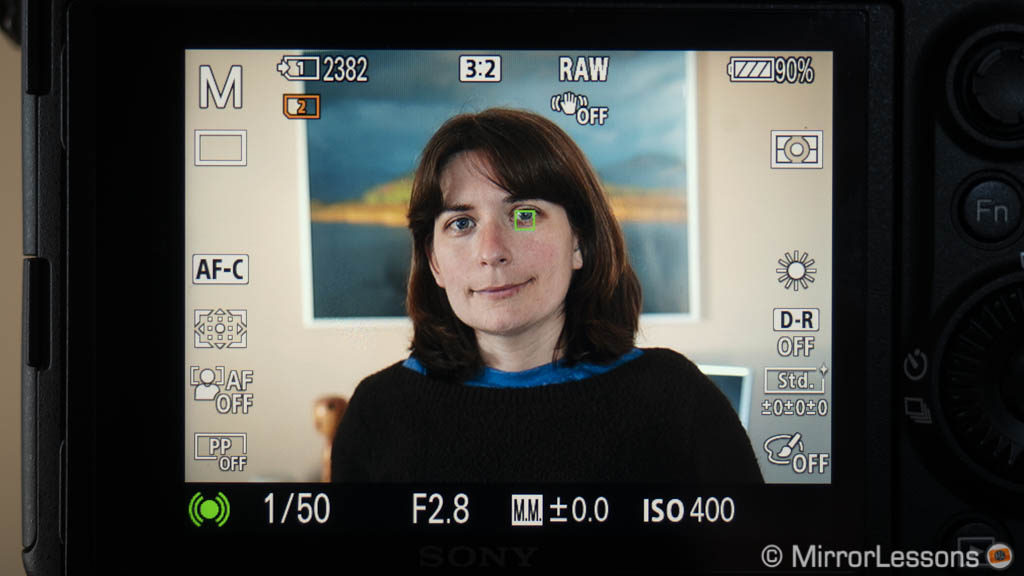
Sony has made EyeAF even better with firmware 3.0 by adding real time performance, which means you don’t need to assign it to a custom button necessarily. Keep in mind though that when used in real time, EyeAF works inside the focus area chosen and not outside. If you assign it to a custom button however, it will bypass whatever AF area you’re using and track the eye everywhere in the frame. It’s a shame that Sony forgot to add the option of prioritising the left or right eye, which is possible on the less expensive a6400.


The only time EyeAF struggled was with the girl below who squinted while posing. It may have also been because her face was entirely painted in black, but the camera stopped detecting the eyes for a few moments and I had to take a few more shots to make sure the focus was correct.

The X-H1 can be very precise when it wants to be, but can also hesitate or fail to see a face, even when it’s right in front of the lens. Or it can detect it but mis-focus. Furthermore, the camera sometimes detects faces in scenes that don’t feature a human being, a tendency I’ve noticed with other Fuji cameras as well. So you can’t trust it as much as you can trust the A7 III. Another small drawback is that with continuous AF, eye detection doesn’t work.
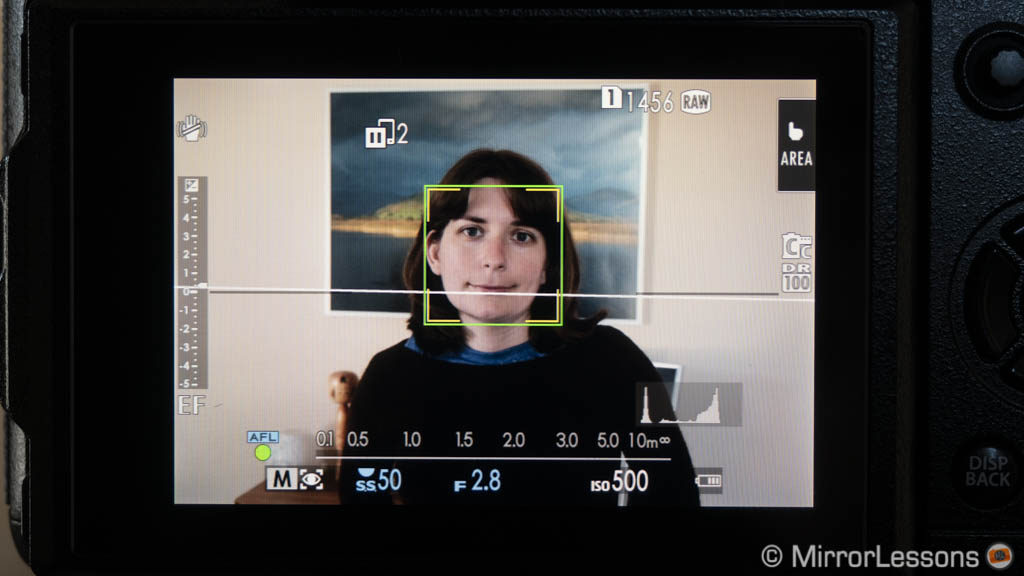



An example of face detection failing: both faces were detected, but neither is sharp.
The Sony also gives you the opportunity to register faces to recognise them more quickly if you shoot the same subject regularly. You can register more than one face and decide which one gets priority.
Note: both cameras allow you to use face detection for video as well and I talk about the performance in the video section.
The firmware update 3.0 brings EyeAF for animals on the A7 III. It works just as well as it does for people but you have to choose in the menu if you want to track humans and animals, it can’t track both in the same shot.
EyeAF is very successful with dogs and cats, as well as sheep and lambs. You need to be close to your subject: the animal has to fill a large area of the frame for eye detection to activate. It doesn’t work with birds however.
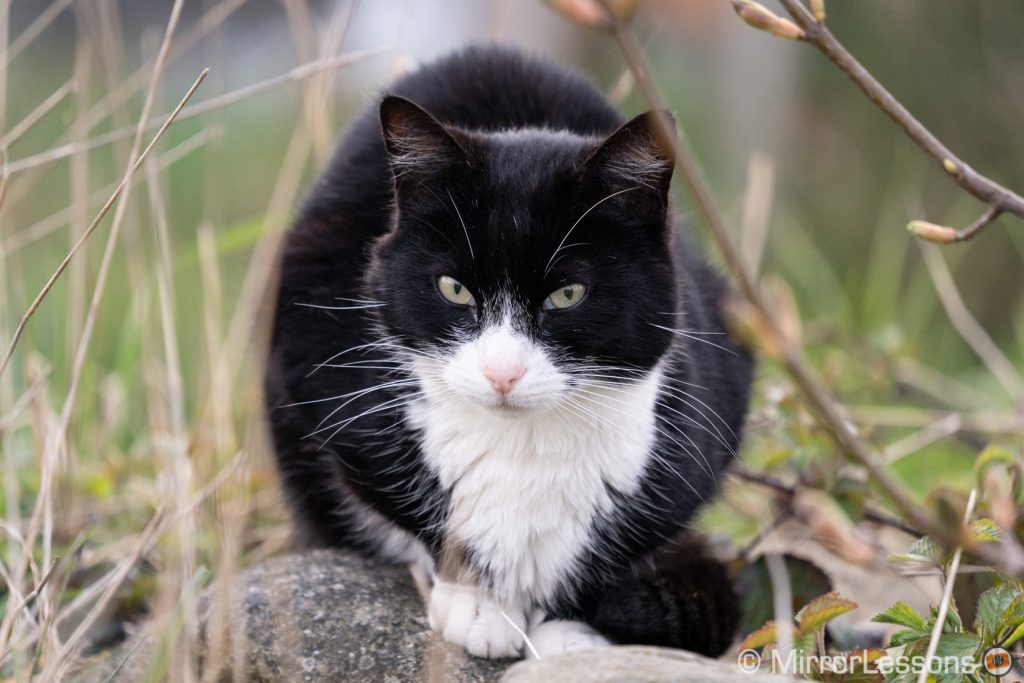
Continuous autofocus and keeper rate
Let me start by saying that the continuous autofocus of both cameras does really well concerning speed, accuracy and the overall keeper rate.
In our first basic running test, neither camera delivered any out-of-focus shots. There were just a few slightly soft photographs (marked in yellow below).



You may wonder why there are more images in the X-H1 burst since both were shot at 8fps. It’s not a buffer issue because as I’ll show further down, the Sony does better in that department.
One explanation is that with focus priority, the Sony only released the shutter when the image was perfectly in focus. I noticed that the burst speed decreased near the end when the subject was closer to the camera and was slowing down. But it also means that the X-H1 has less trouble firing off a burst while continuing to track a subject in the same conditions. If you want to avoid this on the A7, it’s better to set the camera to Balanced Emphasis.
As usual with our complete comparisons, we go beyond the simple running test to push the cameras to their limits!
One difference that became clear to me after using both of them for two weeks is how fast and precise the Sony is when it comes to understanding the subject, and how accurately the camera keeps the focus points on it. Very rarely does it confuse the subject with the background or focus on something else entirely.
The A7 III uses Sony’s 4D Focus technology that concentrates as many phase detection points as needed on the subject. It’s a feature that the company has improved over the years and it’s quite impressive to see how those little green dots on the screen always dance around the subject, no matter what the light or speed conditions are.

Another feature that has improved a lot is Lock-On AF especially when used with the expand flexible spot. The way the phase detection points were constantly “glued” to the goose below despite his and my movements was quite amazing. Of course the camera can occasionally fail to focus in these situations, but it only takes one or two frames to get back on track.

The X-H1 can be slower when it comes to detecting a subject and using the appropriate focus points, and it can also confuse the subject with the background or similar elements more easily. I noticed this difference when taking pictures of red kites in flight, since the plumage of the bird is similar to the colours of the background.


The X-H1 can also be slower to adjust focus when the subject is out of focus at the beginning of the burst. However it can also be spot on, so I ended up with some bursts that were completely out of focus and others that were perfect. Overall, my keeper rate was around 62% (or 83% if I include slightly soft images) with Set 4 and the 7×7 Zone grid, which is good but no better than what I got with the X-T2 and X-Pro2 using the same lens.



The A7 III performed better for birds in flight, giving me a keeper rate of 77% or 96% if I include slightly soft results. That’s very close to the performance of the A9, which is currently the best mirrorless I’ve ever tested for this genre and whose performance is almost equal to that of the Nikon D500. That tells you how good the A7 III is.


I ended up with very few out of focus shots, and the camera was very reactive overall. I used Zone Area most of the time with the AF Track Sensor set to +5. Curiously though, despite the better performance, my favourite shots out of these two different sessions were taken with the Fuji, mainly because that day the birds flew for longer and were also passing closer in comparison to the day I used the Sony. This is a good reminder that even with the best gear, there are still other factors that can contribute to a successful shoot. Obviously with more time and fewer “shy” kites, I have no doubt that the A7 III would have given me better shots (not that I should really complain too much about the ones I have).



The next field test was a football game in the evening, which started just before sunset so with good light conditions that gradually decreased until the end of the second half time. The A7 III gave me an excellent keeper rate of 80%/92%, proving once again how fast and reliable it is.


A couple of times, a series of shots was completely out of focus even though the situation didn’t present any particular challenge (one was with two players waving at the camera after scoring a goal, which is a real shame). This was the only flaw I encountered however.
The moral of the story is that the A7 III can be slow to react on the odd occasion. It’s better to keep the AF Track Sens between 3 and 2 so that the camera isn’t encouraged to change the focus point too often and it helps avoid momentary obstacles. Working with a slower lens like the 100-400mm f/4.5-5.6 doesn’t decrease the performance.



The X-H1 performed well too with an average of 70/78% in-focus shots or 94-95% including the slightly soft images. The reactivity of the camera and its ability to track a subject can vary a little depending on the AF-C Custom settings you choose. Set 4 gives more reactivity but ignores momentary obstacles like another player passing in front of the one you’re following. Set 2 is more appropriate for group sports.


Zone AF works well with a 3×3 or 5×5 grid, and Wide/Tracking can be even more accurate although a bit more unpredictable when it decides to track the ground or the background rather than the player (but to be fair, it didn’t happen often). The camera performed well with the 100-400mm as well as the faster 50-140mm f2.8.



As mentioned earlier, there is a difference between the two cameras when it comes to low light sensitivity. The A7 III is rated with -3Ev which is two times more sensitive than the X-H1 at -1Ev. During the evening sports game, I didn’t find a drastic difference so I was curious to see if a more extreme test would reveal something more.
Below the subject walked towards the camera in a very dark scene (I had to shoot at 12800 ISO with a 2.8 aperture) and the only real difference I found was that the X-H1 gave more inaccurate results overall. However only the Sony produced one completely out-of-focus shot.


One final note concerns stopped-down focusing. In Single AF, the Sony opens the aperture before acquiring focus in order to let more light through and evaluate the focus better. Then it returns to the value you selected when taking the shot. In continuous mode however, the camera keeps the aperture selected by the user at all times. This happens even if you turn the Live View Settings Effect to off. In my tests the X-H1 seem to have the same behaviour.
Personally, I didn’t came across a situation where this posed a problem. Even by stopping down the 70-200mm f2.8 to f/5.6 during the football game, the A7 III’s performance didn’t decrease. I can imagine a situation where it might be more annoying such as in a studio working with flash. Also keep in mind that the Sony with certain lenses like the FE 85mm f/1.4 GM uses stopped-down focusing in S-AF too.
Shutter, continuous shooting speeds and buffer
The first thing you’ll notice if you take a picture with these two cameras is the distinct difference in shutter sound. The A7 III is much louder, whereas Fujifilm managed to improve the already quiet mechanism of the X-T2, which makes the shutter of the X-H1 one of the quietest of any mirrorless camera I’ve used to date.
Both cameras can shoot up to 1/8000s with the mechanical and electronic first curtain shutter. With the all-electronic version, the speed increases to 1/32000s on the X-H1 whereas it remains the same on the A7 III. As usual, keep in mind that electronic shutters produce the rolling shutter effect when peforming quick movements as you can see below.


The A7 III can go as low as 30 seconds. For longer exposures you need to use the Bulb mode, which means pressing and holding down the shutter button for the entire duration. This can cause unwanted micro movements and a loss in sharpness. One solution is to use a remote controller or the Playmemories app on your phone with the Control with Smartphone option on the camera.
In addition to Bulb, the X-H1 has a mode for long exposures called Time: you can set it up to 15 minutes and you don’t need to hold your finger on the shutter button. You can take advantage of the touch screen to start the exposure: if you touch it gently, there’s less of a chance you’ll cause a micro vibration.
In continuous shooting mode, the A7 III can fire as fast as 10fps. Up to 8fps you get live view with blackouts whereas at the fastest frame rate the last image taken is shown instead. There are also Mid/5fps and and Low/3fps speeds.
The X-H1 has three different shooting speeds: 8fps (CH) without live view, CM at 6fps with live view and electronic first curtain shutter, and CL at 5fps with live view. The speed for each mode can be customised with the exception of the CM mode. If you use the electronic shutter, the speed can go as fast as 14fps with continuous AF. If you mount the optional battery grip, the speed with the mechanical shutter increase to 11fps.
As for the buffer, both cameras do well with SOOC JPGs and never slow down when shooting at 8fps, regardless of the type of card used (UHS-I or UHS-II).
With RAW files however, the Sony can keep shooting for up to 30 seconds (26s with a UHS-I card) whereas the Fuji slows down to 5fps after 4 seconds, 3fps after 15 seconds and occasionally pauses for 1 second.
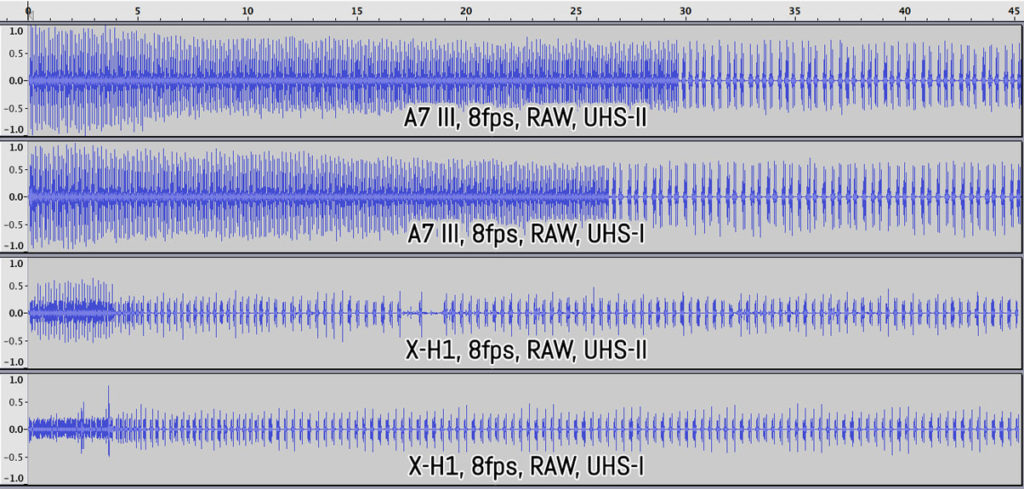
This article continues on page 4.
Check the price of the Sony A7 III on
Amazon | Amazon UK | B&H Photo | eBay
Check price of the Fujifilm X-H1 on
Amazon | Amazon UK | B&H Photo | eBay
Second-hand Sony cameras on
Second-hand Fujifilm cameras on

